Unlock the secret to the most mouth-watering, perfectly cooked prime rib roast you’ve ever tasted with this incredibly simple rotisserie method. Forget complicated oven recipes and endless pan-flipping; our Rotisserie Prime Rib Roast Recipe guarantees a succulent, tender, and deeply flavorful beef experience every single time. It’s so effortlessly delicious, you might find yourself buying a rotisserie just for this recipe!
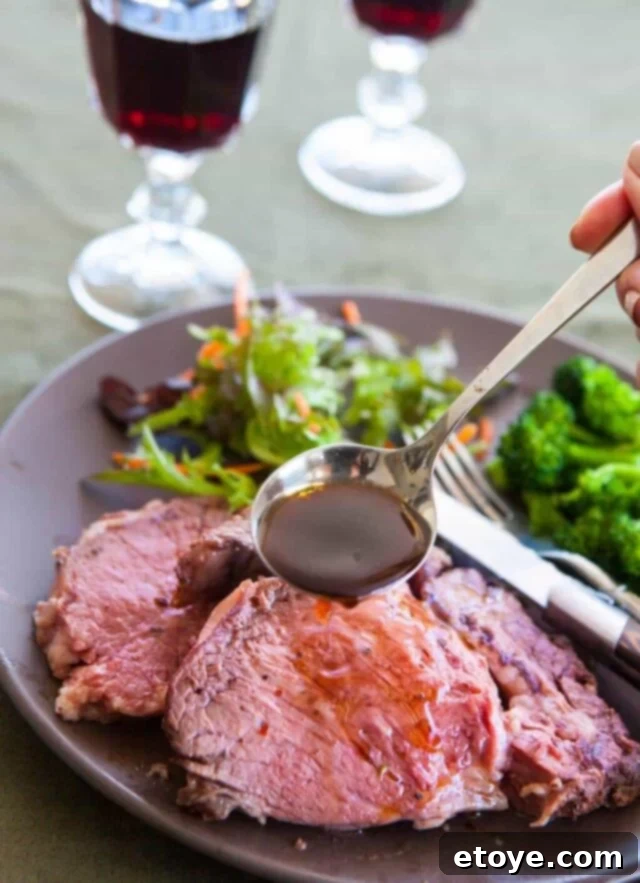
Why This Rotisserie Prime Rib Roast Recipe Is a Must-Try
If you’ve ever shied away from making prime rib at home, thinking it’s too complex or only for seasoned chefs, this recipe will change your mind. Our rotisserie approach transforms a daunting task into an incredibly straightforward and rewarding culinary journey.
- Effortless Preparation and Cooking: Say goodbye to the multi-step acrobatics of traditional roasting. The rotisserie method streamlines the entire process, allowing you to achieve a gourmet meal with minimal fuss. No constant turning, no basting, just set it and let the rotisserie work its magic.
- Consistently Perfect Results: This recipe is virtually foolproof! The continuous rotation of the rotisserie ensures that your prime rib cooks evenly on all sides, resulting in a beautifully caramelized exterior and an unbelievably juicy, tender interior, every single time.
- Steakhouse-Quality at Home: Experience the luxurious taste and texture of a premium steakhouse prime rib without the hefty price tag. The even heat distribution and self-basting action of the rotisserie create a superior roast that rivals professional preparation.
- Ideal for Special Occasions and Holidays: Impress your guests and family with a show-stopping main course that looks and tastes exquisite. Its simplicity means less stress for you, making it the perfect centerpiece for holiday gatherings, dinner parties, or any memorable celebration.
- Rich, Flavorful Au Jus: The design of the rotisserie allows all those precious meat drippings to collect perfectly in a pan below, providing the essential foundation for a rich, savory red wine au jus that elevates the entire dish.
Essential Ingredients for Your Rotisserie Prime Rib
Creating an unforgettable prime rib doesn’t require a long list of exotic ingredients. Quality ingredients, simply prepared, are the key to a truly magnificent roast. Here’s what you’ll need:
- Bone-in Prime Rib Roast: The star of the show. Choosing a good quality cut is paramount for flavor and tenderness.
- Salt and Pepper: The fundamental seasonings that enhance the beef’s natural flavor. Don’t be shy – a generous seasoning is crucial for a great crust.
- Carrots, Celery, Onion: These aromatic vegetables form the base for your rich au jus, infusing it with deep, savory notes as they roast.
- Fresh Thyme: Adds an earthy, aromatic dimension to both the roast and the au jus.
- Red Wine: A good quality red wine will deglaze the pan and add complexity and depth to your au jus. Choose one you’d enjoy drinking!
- Beef Broth: Essential for building the body and flavor of your delicious au jus.
Mastering the Rotisserie Prime Rib: A Step-by-Step Guide
Preparing this exquisite rotisserie prime rib is surprisingly straightforward. Follow these steps for a perfect roast that will have everyone asking for your secret.
Step 1: Preparing Your Prime Rib for Roasting
Before your prime rib hits the rotisserie, proper seasoning is essential to develop a delicious crust and infuse flavor throughout the meat. Start by patting your bone-in prime rib roast dry with paper towels. This helps the seasoning adhere better and promotes a crispier exterior. Now, generously season the entire roast. While a simple blend of coarse salt and freshly ground black pepper is excellent, feel free to use your favorite steak seasoning blend. A good quality rub, like a Kansas City-style blend, can add wonderful complexity. Massage the seasoning thoroughly into all surfaces of the roast, ensuring every inch is coated. This initial seasoning is crucial for building the flavor profile.
Step 2: Setting Up the Flavor Base for Your Au Jus
The beauty of rotisserie cooking extends beyond the roast itself, as it also creates the perfect foundation for a rich, flavorful au jus. In the roasting pan that sits beneath your rotisserie spit, arrange your prepared vegetables. This typically includes large chunks of carrots, celery stalks, and quartered onions. These vegetables will slowly roast as the prime rib cooks, absorbing the succulent meat drippings and caramelizing to develop deep, sweet flavors. For an extra aromatic touch, tuck in a few sprigs of fresh thyme among the vegetables. These will contribute an herbaceous note that complements the beef wonderfully. This simple step transforms ordinary drippings into a gourmet base for your sauce.

Step 3: Loading the Prime Rib onto the Rotisserie
Now comes the truly simple part: securing your prime rib. Carefully load the seasoned prime rib roast onto your rotisserie spit, ensuring it’s centered and balanced. If your roast has bones, position the rotisserie spikes securely between the bones for stability. Make sure the roast is snug and won’t wobble during rotation. This one-step loading process is a far cry from wrestling a heavy roast in and out of a hot oven. Once loaded, slide the roasting tray with your vegetables beneath the roast. The rotisserie’s design makes this process incredibly user-friendly and fail-proof, setting you up for success from the start.

Step 4: Rotisserie Roasting to Perfection
With your prime rib in place and the vegetables below, it’s time to let the rotisserie do its work. Turn on your rotisserie oven and set the timer according to your desired doneness and the manufacturer’s instructions, which typically provide a cooking chart based on the roast’s weight. As a general guideline, aim for approximately 16-18 minutes per pound for rare to medium-rare results. For instance, we found 18 minutes per pound yields a perfect medium-rare. The continuous, slow rotation ensures the roast cooks evenly, self-basting in its own juices and developing a beautiful, uniform crust. For precise doneness, always use an instant-read meat thermometer. Insert it into the thickest part of the roast, away from the bone. For rare, aim for 125°F; for medium-rare, 130-135°F; for medium, 135-140°F; and for well-done, 160°F. Remember that the internal temperature will rise by a few degrees as the meat rests.
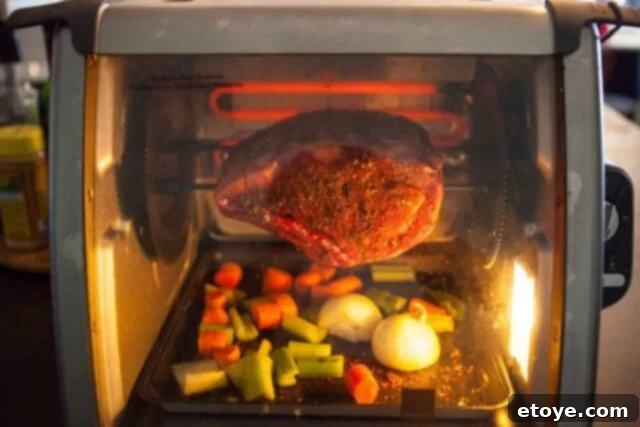
Step 5: Collecting Drippings and Resting the Roast
As your prime rib roasts, all the flavorful drippings will fall conveniently into the pan of vegetables below. This collection of rich, seasoned pan juices and caramelized vegetables is the secret to an extraordinary au jus. Once the prime rib reaches your desired internal temperature, carefully remove it from the rotisserie and transfer it to a cutting board. It’s crucial to let the roast rest, loosely tented with foil, for at least 15-20 minutes before carving. This resting period allows the juices to redistribute throughout the meat, ensuring every slice is incredibly moist and tender. While your roast rests, you can proceed with making the Red Wine Au Jus.

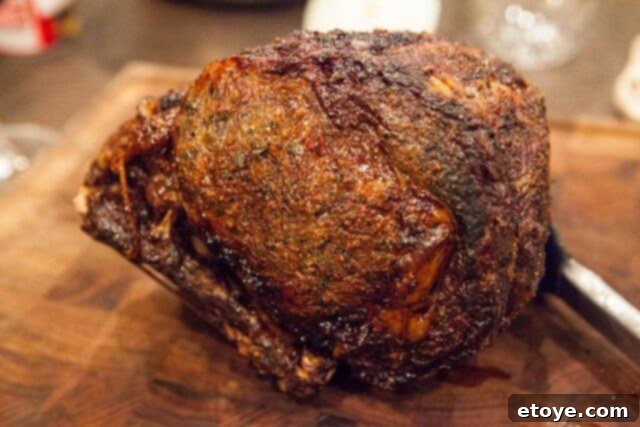
Crafting the Perfect Red Wine Au Jus
A prime rib roast isn’t complete without a rich, savory au jus. Thanks to the rotisserie, you’ve already got the perfect base for an incredible sauce. Here’s how to turn those delicious drippings into a gourmet accompaniment.
Step 1: Transferring the Pan Contents
Once your prime rib is resting, carefully pour the entire contents of the rotisserie roasting pan – including all the drippings and roasted vegetables – into a small saucepan. Make sure to scrape any caramelized bits from the bottom of the pan; these are packed with flavor.
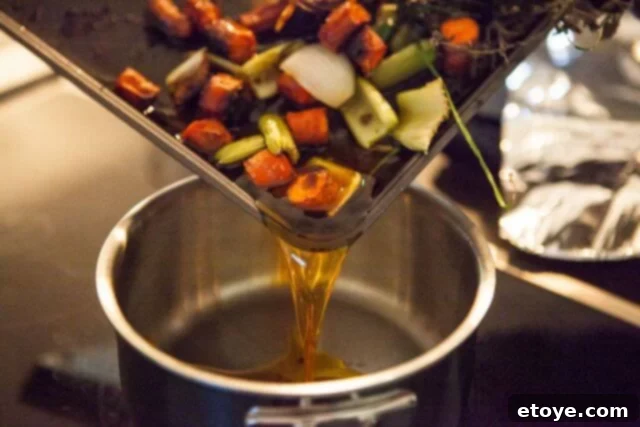
Step 2: Adding Red Wine
Place the saucepan over medium-high heat. Pour in 1 cup of a good quality red wine. The wine will deglaze the pan, helping to lift all those flavorful browned bits from the bottom, while adding a beautiful depth and acidity to the sauce. Let the wine simmer and reduce slightly, allowing the alcohol to cook off and concentrating its flavor.

Step 3: Incorporating Beef Broth
Next, add 1 cup of high-quality beef broth to the saucepan. This will provide the necessary liquid and beefy notes to complete your au jus. Combine all the ingredients well, stirring gently to ensure everything is mixed.
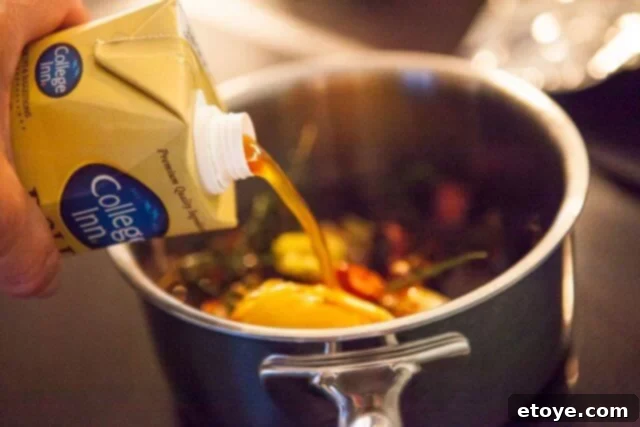
The combination of Pan Drippings + Roasted Vegetables + Red Wine + Beef Broth creates a truly unforgettable Red Wine Au Jus.
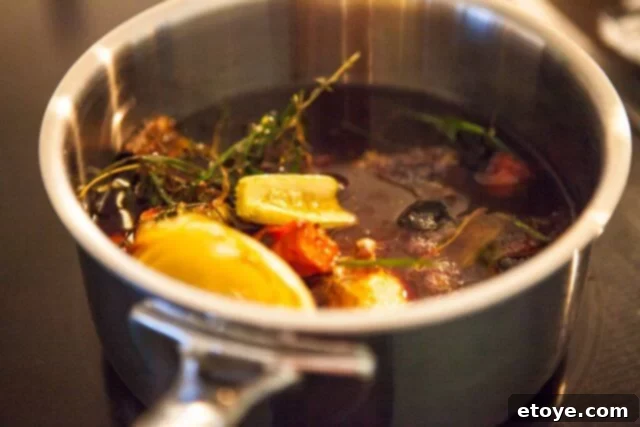
Step 4: Simmering for Flavor Development
Allow the au jus to simmer gently, uncovered, for about 8 minutes. This simmering period allows the flavors to meld and deepen, and the sauce to reduce slightly, intensifying its richness. Taste and adjust seasoning as needed.
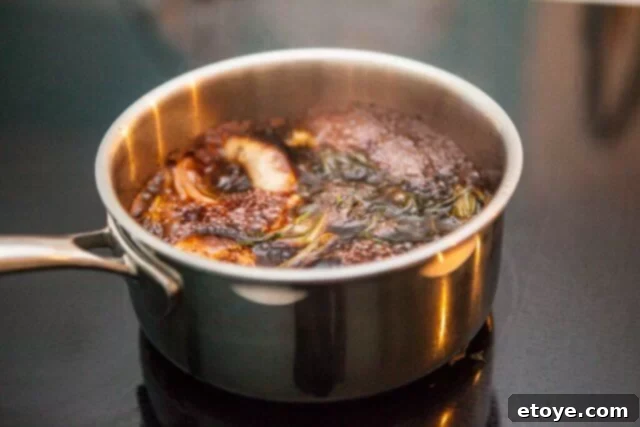
Step 5: Straining and Serving
Once the au jus has simmered to perfection, strain it through a fine-mesh sieve into a clean serving vessel. This will remove the cooked vegetables and thyme sprigs, leaving you with a smooth, clear, and intensely flavored sauce. Your Red Wine Au Jus is now ready to be served alongside your magnificent rotisserie prime rib roast.
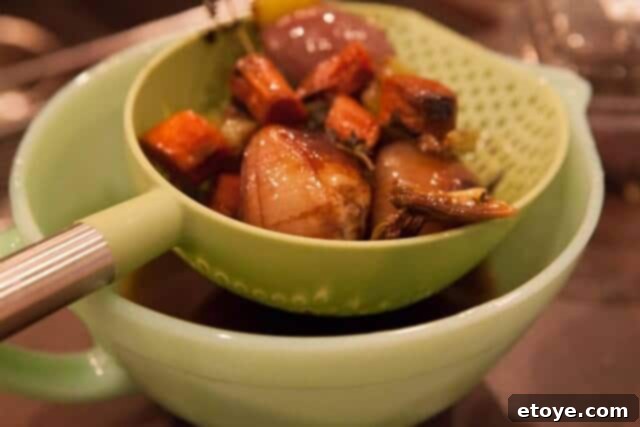
The Simplicity of Rotisserie Prime Rib: A Game Changer
For too long, the idea of making a prime rib roast at home has been associated with complexity and potential culinary disasters. Many traditional recipes involve a multi-step process: searing the roast in a blazing hot cast-iron pan, carefully transferring the heavy, sizzling meat to a roasting pan, and then slow-roasting it in the oven. This method often requires constant attention, precise temperature control, and a good dose of kitchen “acrobatics” to handle such a large cut of meat without incident. While these methods can yield delicious results, they often deter home cooks from attempting this impressive dish.
This is where the rotisserie oven shines as a true game-changer. It eliminates all the awkward, high-stress steps, providing a one-step, fail-proof method that consistently produces results superior to what many achieve with conventional roasting. The rotisserie ensures that your prime rib cooks evenly, developing a perfect crust on all sides without any manual intervention. This revolutionary approach not only simplifies the cooking process but also enhances the final quality of the roast, making it remarkably juicy and tender. If you’ve ever dreamt of serving a perfectly cooked prime rib without the hassle, the rotisserie is your ultimate solution.
For those interested in exploring rotisserie cooking, many reliable models are available on the market. A quality home rotisserie can quickly become one of the most used appliances in your kitchen due to its ease of operation, simple cleanup, and consistently excellent results.
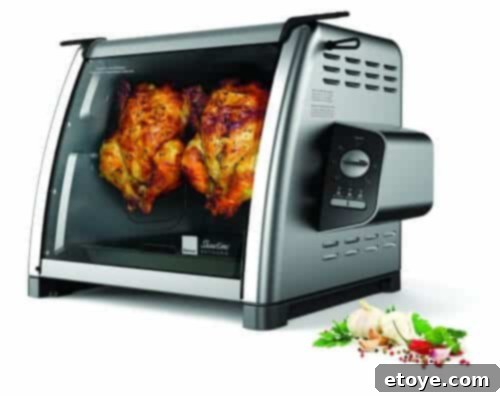
Beyond Chicken: Why Rotisserie is Perfect for Prime Rib
When most people think of a rotisserie, images of golden-brown chickens often come to mind. However, the benefits of rotisserie cooking extend far beyond poultry, making it an exceptional method for other cuts of meat, including lamb roasts, pork tenderloin, and, most notably, prime rib roasts.
The magic lies in the rotisserie’s continuous turning mechanism. This constant rotation serves several critical functions that are particularly advantageous for a substantial cut like prime rib:
- Even Cooking: As the roast slowly turns, it’s exposed to consistent heat from all angles. This eliminates hot spots and ensures the entire roast cooks uniformly, from edge to center.
- Self-Basting: The rotating action allows the meat’s natural juices and rendered fat to continuously baste the surface of the prime rib. This self-basting keeps the meat incredibly moist and tender while contributing to an exquisitely crispy, flavorful exterior crust.
- Perfect Crust Development: Unlike static roasting, where only the top surface truly browns, the rotisserie ensures a beautiful, deeply caramelized crust develops evenly on all sides of the prime rib. This crust is packed with flavor and texture.
- Consistent Doneness: The even heat and gentle cooking prevent overcooking on the outside while keeping the center perfectly rare to medium-rare, according to your preference. With a built-in timer that often automatically shuts off, the risk of overcooking is significantly reduced, guaranteeing a perfectly done prime rib based on its weight.
The rotisserie essentially does all the heavy lifting, allowing you to achieve a superior roast with minimal effort and maximum flavor. It’s a method that truly respects the quality of the prime rib, bringing out its best attributes.
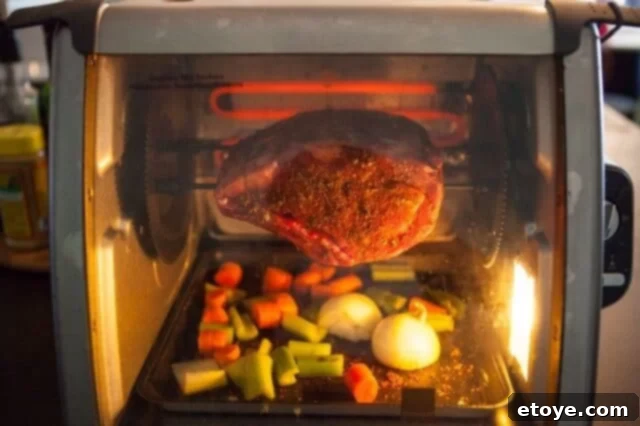
Understanding the Standing Prime Rib Roast
A prime rib roast, also known as a standing rib roast, is a highly prized cut of beef that promises an incredibly flavorful and tender eating experience. Essentially, it’s the same cut of meat from which a rib-eye steak is derived. However, instead of being sliced into individual steaks, the meat is left as a larger roast, often with the bones still attached and sometimes tied to maintain its shape during cooking.
Choosing a high-quality prime rib is key to the success of this recipe. Look for a roast with excellent marbling – those fine streaks of fat woven throughout the meat. Marbling is crucial because it melts during cooking, infusing the beef with moisture and flavor, resulting in a tender and juicy outcome. While premium grades like USDA Prime or Wagyu offer exceptional quality, a well-marbled choice-grade rib roast from a reputable butcher will also deliver fantastic results.
The bone-in aspect of a prime rib is often preferred by connoisseurs. The bones add an extra layer of flavor and insulation during cooking, which can contribute to a more tender and flavorful roast. Many enthusiasts even consider the meat clinging to the bones after carving to be the most delicious part! Don’t hesitate to enjoy every savory morsel, just like a true meat lover.

Carving Your Rotisserie Prime Rib Roast with Ease
Once your magnificent rotisserie prime rib has rested adequately, it’s time for the final, satisfying step: carving. A well-carved roast not only makes for beautiful presentation but also ensures everyone gets a perfect slice.
Step 1: Removing the Bones
For easier carving and serving, the first step is to carefully remove the bones from the roast. Place the prime rib on your cutting board with the bone side facing you. Using a sharp carving knife, slice along the contour of the bones, separating them from the main body of the meat. Follow the natural curve of the bones as closely as possible to maximize the yield of meat.
Once removed, the bones can be further cut into individual portions – often considered a chef’s treat for those who enjoy gnawing on the savory, succulent bits of meat closest to the bone!
Step 2: Slicing the Roast
With the bones removed, you now have a boneless roast ready for slicing. Position the roast so you can slice it crosswise, against the grain of the meat. Slicing against the grain is crucial as it shortens the muscle fibers, resulting in a much more tender bite. Slice the prime rib roast into your desired thickness, typically between 1/2 to 3/4 inch for a hearty serving. You can pre-slice the entire roast or carve it tableside for an impressive presentation.
Step 3: Serving with Au Jus
Arrange the carved slices of prime rib on a warm serving platter. Drizzle generously with the rich Red Wine Au Jus you prepared, or serve the au jus on the side in a gravy boat for guests to add to their liking. Garnish with a sprig of fresh herbs, like rosemary or thyme, for an elegant touch.
Choosing the Right Rotisserie Oven
Investing in a good rotisserie oven can transform your home cooking, making gourmet dishes like this prime rib roast remarkably accessible. When selecting a rotisserie, consider factors such as size, features, and durability. Many models offer space-saving designs, while others boast larger capacities for bigger roasts or multiple items. Look for models with easy-to-use controls, reliable timers, and components that are simple to clean. Researching reviews and comparing features from various brands will help you find the perfect rotisserie to suit your culinary needs and kitchen space.
Top Tips for an Impeccable Prime Rib Roast
To ensure your rotisserie prime rib roast is nothing short of spectacular, keep these key tips in mind:
- Seasoning is Key: Don’t underestimate the power of seasoning. A generous application of coarse salt and freshly ground black pepper is a fantastic start. Experiment with other spices like garlic powder, onion powder, paprika, or a pre-made beef rub to customize the flavor profile. Ensure the entire surface of the roast is well-coated for optimal crust development.
- Monitor Internal Temperature, Not Just Time: While minutes per pound provides a good guideline, the most accurate way to determine doneness is with an instant-read meat thermometer. Different rotisserie models, oven calibrations, and even the starting temperature of your roast can affect cooking times. Target 125°F for rare, 130-135°F for medium-rare, and remember the temperature will rise a few degrees during resting.
- Resting is Non-Negotiable: After cooking, letting your prime rib rest for at least 15-20 minutes, loosely tented with foil, is crucial. This allows the meat fibers to relax and reabsorb the juices, ensuring a tender and moist roast. Skipping this step can result in a dry, less flavorful prime rib.
- Carve Against the Grain: For the most tender slices, always carve your prime rib across the grain of the meat. This shortens the muscle fibers, making each bite easier to chew and more enjoyable. Identifying the grain can be tricky, but generally, it runs parallel to the length of the roast.
- Don’t Waste the Bones: If you’re using a bone-in roast, save the separated bones! They are packed with flavor and can be used to make an incredibly rich beef stock or simply savored as a chef’s treat.
- Fresh Herbs Make a Difference: While dried herbs can be used, fresh thyme or rosemary tucked into the roasting pan or even under the netting of your roast will infuse a brighter, more vibrant aroma and flavor.
Explore More Delicious Recipes
Complement your perfect prime rib roast with these delectable side dishes and main courses:
- Perfect Prime Rib Recipe with Red Wine Jus
- Roasted Garlic Mashed Potatoes
- Classic Yorkshire Pudding
- Ruth’s Chris Sweet Potato Casserole Recipe
- Dr. BBQ’s Famous Baby Back Ribs
We hope you thoroughly enjoy preparing and savoring this incredible Rotisserie Prime Rib Roast recipe. Feel free to leave a star rating and share your experience in the comments below! We’d love to hear how it turned out for you.

Prime Rib Roast Recipe on Rotisserie
Jaden Hair
This Prime Roast Rib recipe is done on the rotisserie and couldn’t be simpler! It cooks up the most delicious, succulent and tender beef. Worth buying a rotisserie just for this!
Pin Recipe
Preparation & Cooking Times
| Prep Time: | 10 mins |
| Cook Time: | 4 hrs |
| Total Time: | 4 hrs 10 mins |
Recipe Details
| Course: | Main Course |
| Cuisine: | American |
| Servings: | 6 servings |
| Calories: | 959 kcal |
Ingredients
- One bone-in prime rib roast
- Salt and pepper or seasoning blend of your choice
- 3 carrots, peeled, cut in big chunks
- 3 stalks celery, cut in big chunks
- 1 large onion, quartered
- Several sprigs of thyme
- 1 cup red wine
- 1 cup beef broth
Instructions
- Season the rib roast generously on all sides. Load the rib roast onto the rotisserie, with spikes between the bones. Scatter the carrots, celery, onion, and thyme in the roasting tray. Insert roasting tray into rotisserie. Set rotisserie to cook according to manufacturer’s instructions.
- Please read your rotisserie manual for specific cooking time charts, as your machine may be different. When done, let the roast rest while you make the Red Wine Au Jus. Pour the contents of the roasting pan into a medium saucepan set on medium-high heat.
- Add the red wine and beef broth. Simmer on low for 8 minutes, uncovered. Strain and serve with the Prime Rib Roast. To carve the Prime Rib Roast, first, cut off the bones. Cut each bone apart. Then slice the rib roast into desired thickness against the grain.
Notes
Rotisserie cook time will vary; always check your manufacturer’s instructions and use a meat thermometer for accurate doneness.
Nutrition
Carbohydrates: 6 g
Protein: 42 g
Fat: 81 g
Saturated Fat: 34 g
Cholesterol: 183 mg
Sodium: 696 mg
Potassium: 865 mg
Fiber: 1 g
Sugar: 3 g
Vitamin A: 5104 IU
Vitamin C: 3 mg
Calcium: 43 mg
Iron: 5 mg
Keywords
beef roast, prime rib recipe, rotisserie beef
Tried this recipe?
Let us know how it was!
